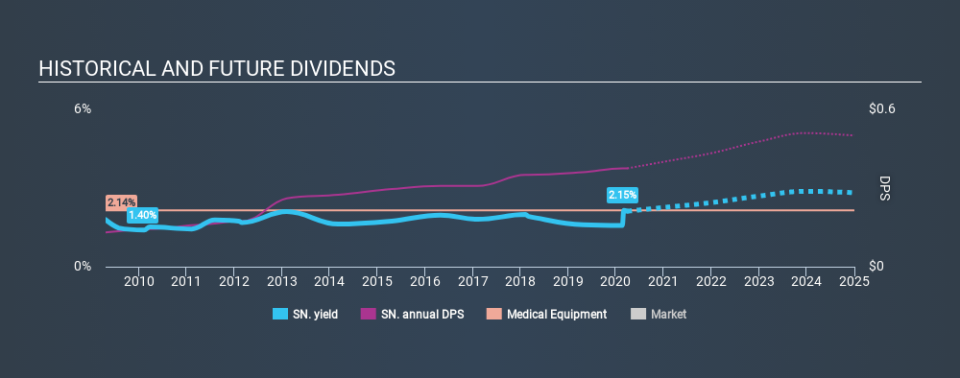Smith & Nephew plc (LON:SN.) Will Pay A US$0.23 Dividend In 2 Days

Smith & Nephew plc (LON:SN.) stock is about to trade ex-dividend in 2 days time. This means that investors who purchase shares on or after the 2nd of April will not receive the dividend, which will be paid on the 6th of May.
Smith & Nephew's next dividend payment will be UK£0.23 per share, on the back of last year when the company paid a total of UK£0.38 to shareholders. Based on the last year's worth of payments, Smith & Nephew has a trailing yield of 2.1% on the current stock price of £14.275. Dividends are a major contributor to investment returns for long term holders, but only if the dividend continues to be paid. So we need to check whether the dividend payments are covered, and if earnings are growing.
View our latest analysis for Smith & Nephew
Dividends are usually paid out of company profits, so if a company pays out more than it earned then its dividend is usually at greater risk of being cut. Smith & Nephew is paying out an acceptable 55% of its profit, a common payout level among most companies. Yet cash flows are even more important than profits for assessing a dividend, so we need to see if the company generated enough cash to pay its distribution. Thankfully its dividend payments took up just 42% of the free cash flow it generated, which is a comfortable payout ratio.
It's positive to see that Smith & Nephew's dividend is covered by both profits and cash flow, since this is generally a sign that the dividend is sustainable, and a lower payout ratio usually suggests a greater margin of safety before the dividend gets cut.
Click here to see the company's payout ratio, plus analyst estimates of its future dividends.
Have Earnings And Dividends Been Growing?
Stocks in companies that generate sustainable earnings growth often make the best dividend prospects, as it is easier to lift the dividend when earnings are rising. If business enters a downturn and the dividend is cut, the company could see its value fall precipitously. This is why it's a relief to see Smith & Nephew earnings per share are up 4.1% per annum over the last five years. Earnings growth has been slim and the company is paying out more than half of its earnings. While there is some room to both increase the payout ratio and reinvest in the business, generally the higher a payout ratio goes, the lower a company's prospects for future growth.
Another key way to measure a company's dividend prospects is by measuring its historical rate of dividend growth. In the past ten years, Smith & Nephew has increased its dividend at approximately 11% a year on average. It's encouraging to see the company lifting dividends while earnings are growing, suggesting at least some corporate interest in rewarding shareholders.
Final Takeaway
From a dividend perspective, should investors buy or avoid Smith & Nephew? Earnings per share growth has been modest and Smith & Nephew paid out over half of its profits and less than half of its free cash flow, although both payout ratios are within normal limits. Overall, it's hard to get excited about Smith & Nephew from a dividend perspective.
While it's tempting to invest in Smith & Nephew for the dividends alone, you should always be mindful of the risks involved. In terms of investment risks, we've identified 1 warning sign with Smith & Nephew and understanding them should be part of your investment process.
A common investment mistake is buying the first interesting stock you see. Here you can find a list of promising dividend stocks with a greater than 2% yield and an upcoming dividend.
If you spot an error that warrants correction, please contact the editor at editorial-team@simplywallst.com. This article by Simply Wall St is general in nature. It does not constitute a recommendation to buy or sell any stock, and does not take account of your objectives, or your financial situation. Simply Wall St has no position in the stocks mentioned.
We aim to bring you long-term focused research analysis driven by fundamental data. Note that our analysis may not factor in the latest price-sensitive company announcements or qualitative material. Thank you for reading.

 Yahoo Finance
Yahoo Finance 
